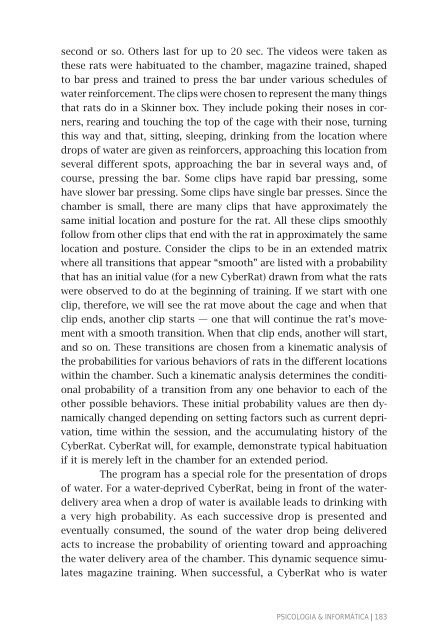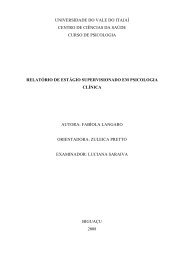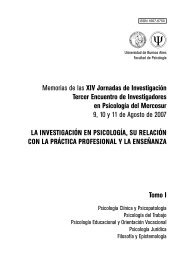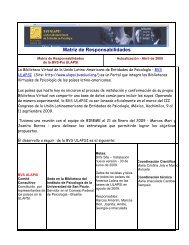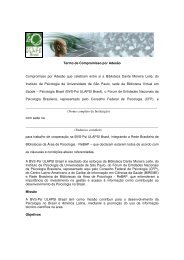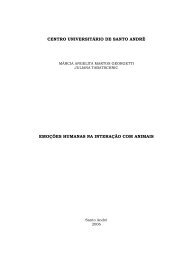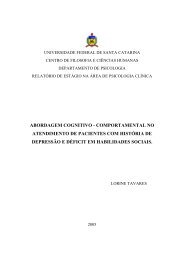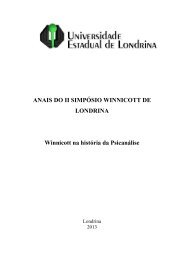- Page 2 and 3:
PSICOLOGIA& INFORMÁTICAProduções
- Page 4 and 5:
APRESENTAÇÃOApós os primeiros ci
- Page 6 and 7:
SUMÁRIOApresentação 3Subjetivida
- Page 8:
Teleavaliação de leitura e escrit
- Page 11 and 12:
A PSICODINÂMICA DO TRABALHO DOS AN
- Page 13 and 14:
como aquela que não produz nenhum
- Page 15 and 16:
sionais para que sejam preenchidas
- Page 17 and 18:
Existe, portanto, uma relação amb
- Page 19:
“No início, a coisa era complica
- Page 23 and 24:
AS PRINCIPAIS “PLATAFORMAS” DE
- Page 25 and 26:
Primeiramente, os celulares são re
- Page 27 and 28:
menta no ciberespaço). Já a possi
- Page 29 and 30:
CONCLUSÃOSensações de segurança
- Page 31 and 32:
Nicolaci-da-Costa, A. M. (2004a). I
- Page 33 and 34:
formações de relações, de encon
- Page 35 and 36:
ligações das conclusões obtidas
- Page 37 and 38:
possuir mais de 61 amigos no Orkut.
- Page 39 and 40:
através do mundo virtual nada mais
- Page 41 and 42:
procuram pessoas com característic
- Page 43 and 44:
Carvalho, P. R. (2004) Psicologia,
- Page 45 and 46:
Lévi-Strauss, C. (1958) A estrutur
- Page 47 and 48:
Recuero, R. C. (2001) Comunidades V
- Page 49 and 50:
O ORKUT NA CLÍNICA E A RELAÇÃOTE
- Page 51 and 52:
dosos e se expõem bem menos. É po
- Page 53 and 54:
fóruns sem conseguir se relacionar
- Page 55 and 56:
nas para a figura do médico, mas t
- Page 57 and 58:
gem, que inclui aceitação integra
- Page 59 and 60:
Outra pergunta. O terapeuta deve ac
- Page 61 and 62:
merece atenção por parte dos psic
- Page 63 and 64:
Aproximadamente trinta anos após o
- Page 65 and 66:
(Isaac, 1983). A análise de sítio
- Page 67 and 68:
var milhares de anos para produzir
- Page 69 and 70:
Qualquer outra forma de comunicaç
- Page 71 and 72:
Cosmides, L. & Tooby J. (1992). Cog
- Page 73 and 74:
JOGOS ELETRÔNICOS E VIOLÊNCIA - D
- Page 75 and 76:
É através da mixagem das linguage
- Page 77 and 78:
sem deixar vestígios. Um exemplo d
- Page 79 and 80:
sivos, reduzindo, assim, qualquer d
- Page 81 and 82:
investimento do próprio sistema de
- Page 83 and 84:
Silva, M. L. M. da (1997). Vidrados
- Page 85 and 86:
trabalhavam e quais os agravos à s
- Page 87 and 88:
sistêmicas das ferramentas, supond
- Page 89 and 90:
da tensão como relacionada às con
- Page 91 and 92:
3- A tecnologia destrói algumas fr
- Page 93 and 94:
REDES NEURAIS ARTIFICIAS COMO METÁ
- Page 95 and 96:
Camadade inputCamadaencobertaCamada
- Page 97 and 98:
WX 1 1y 1...WX 2 2a iWX n nFigura 2
- Page 99 and 100:
A idéia de uma sinapse ajustável
- Page 101 and 102:
parcial sobre uma pessoa, p. ex., o
- Page 103 and 104:
PROTOCOLO PARA MODELAGEM EM PSICOPA
- Page 105 and 106:
Gonzalez, H.J. (1993). Using neural
- Page 107 and 108:
COMPUTAÇÃO AFETIVA : VÍNCULOS CO
- Page 109 and 110:
pode ser vista como um estado afeti
- Page 111 and 112:
A essas perspectivas aliam-se as pe
- Page 113 and 114:
meiros trabalhos nesse sentido foi
- Page 115 and 116:
CONSIDERAÇÕES FINAISA Computaçã
- Page 117 and 118:
USABILIDADE PARA TODOS: A IMPORTÂN
- Page 119 and 120:
é usável - de modo absoluto - sem
- Page 121 and 122:
vemos pensar sobretudo na qualidade
- Page 123 and 124:
IHC ajuda-nos a entender por que al
- Page 125 and 126:
ção, assim como assumir a idéia
- Page 127 and 128:
de nosso tempo. A idéia de conatus
- Page 129 and 130:
la, que faz um histórico das ciên
- Page 131 and 132:
de começar a pensar a epistemologi
- Page 133 and 134: A Inteligência Artificial, que nas
- Page 135 and 136: REFERÊNCIASAtlan, H. (2000) O livr
- Page 137 and 138: II JORNADA DE PSICOLOGIA E INFORMÁ
- Page 139 and 140: a como tal, a menos que tenha seu e
- Page 141 and 142: ESTRUTURAÇÃO ATUAL DA EQUIPE 1Em
- Page 143 and 144: Psicoinfo 2 , de uma mesa redonda s
- Page 145 and 146: foi aberto também aos profissionai
- Page 147 and 148: ais tamagochis. Brinquedos que esti
- Page 149 and 150: BRINCARBrinquedos e brincadeiras es
- Page 151 and 152: mente e que tem que trabalhar para
- Page 153 and 154: SISTEMA DE AVALIAÇÃO PSICOLÓGICA
- Page 155 and 156: internacional. As publicações pos
- Page 157 and 158: • aplicação controlada: não h
- Page 159 and 160: Em relação às características t
- Page 161 and 162: Joly, M.C.R.A. & Silveira, M.A. (20
- Page 163 and 164: ORIENTAÇÃO PSICOLÓGICA VIA E-MAI
- Page 165 and 166: Considerando-se o que Pierry Levy f
- Page 167 and 168: Para Novo (2004):“O ser humano de
- Page 169 and 170: SOFTWARES PARA PESQUISA: RELATODE E
- Page 171 and 172: Apesar de o desenvolvimento de soft
- Page 173 and 174: também teve influência da possibi
- Page 175 and 176: Procure soluções “prontas” na
- Page 177 and 178: testado. Uma vez que o objeto estej
- Page 179 and 180: TEMOS O PRAZER EM TRAZER CYBERRATPA
- Page 181 and 182: to hand in records with different s
- Page 183: cumulative records with different s
- Page 187 and 188: DESENVOLVIMENTO DAS HABILIDADESPSIC
- Page 189 and 190: pequeno, comparado aos países dese
- Page 191 and 192: ·as tecnologias devem ser fáceis
- Page 193 and 194: Figura 3: O site do MesaTenista, um
- Page 195 and 196: desenvolver ferramentas de avaliaç
- Page 197 and 198: atleta livre, sem restrições, par
- Page 199 and 200: Turkle, S. (1995). Life on the scre
- Page 201 and 202: de Figuras por Escrita de Palavras,
- Page 203 and 204: BATERIA DE AVALIAÇÃO DE LEITURA,
- Page 205 and 206: Ensino Médio (i.e., de 36,2 pontos
- Page 207 and 208: subtestes de surdos e ouvintes, o e
- Page 209 and 210: Figura 2: No primeiro plano, as dua
- Page 211 and 212: nais), podem produzir paragrafias s
- Page 213 and 214: para denominar xadrez) e de paragra
- Page 215 and 216: MÉTODOParticipantesParticiparam 44
- Page 217 and 218: subteste PE, a pontuação média d
- Page 219 and 220: quanto para escolas comuns, detecta
- Page 221 and 222: sumariado na tabela, tanto o TCLP1.
- Page 223 and 224: DISCUSSÃOOs dois testes computador
- Page 225 and 226: ao acaso. A menor flutuação na po
- Page 227 and 228: Este estudo ofereceu uma importante
- Page 229 and 230: Capovilla, F. C., Giacomet, A., Cap
- Page 231 and 232: Capovilla, F. C., Mazza, C., Ameni,
- Page 233 and 234: Capovilla, F. C., Viggiano, K. Q.,
- Page 235 and 236:
Nikaedo, C., Macedo, E.C., Diana, C
- Page 237 and 238:
of Internet Relay Chat (IRC, synchr
- Page 239 and 240:
Counselling is a term that indicate
- Page 241 and 242:
The practical difficulties of ensur
- Page 243 and 244:
Confidentiality and its limitations
- Page 245 and 246:
therapy are evidence based professi
- Page 247 and 248:
Suler, J. (1997). Psychological Dyn
- Page 249 and 250:
am e definem (Vygotsky, 1988; Werts
- Page 251 and 252:
ImitaçãoEsperade modeloControledi
- Page 253 and 254:
der uma seqüência de imagens que
- Page 255 and 256:
do leve ao profundo ao longo de vá
- Page 257 and 258:
não conhecem. Em todos os casos, o
- Page 259 and 260:
Sugiyama, T. (1996). Epidemiología
- Page 261 and 262:
Os estudos de Farrell (1999a), Kinn
- Page 263 and 264:
• UFSCar: USE — Unidade Saúde-
- Page 265 and 266:
organizados de forma a que o usuár
- Page 267 and 268:
Registro de atendimentoTipo pergunt
- Page 269 and 270:
Com base nesse modelo, as clínicas
- Page 271 and 272:
A informatização dos registros cl
- Page 273 and 274:
QUESTÃO DO ACESSO ABERTO E A BVS-P
- Page 275 and 276:
mas empresas comerciais dificultam
- Page 277 and 278:
·os provedores de serviços que fu
- Page 279 and 280:
“À medida que o mundo se torna u
- Page 281 and 282:
· CCB — Portal de Revistas em Ps
- Page 283 and 284:
Também segundo o autor, os bibliot
- Page 285 and 286:
Levacov, Marília. (2006). Bibliote
- Page 287 and 288:
Por sua vez, as guerras demandavam
- Page 289 and 290:
em parte, pelo desconhecimento da e
- Page 291 and 292:
com uma equipe composta por diverso
- Page 293 and 294:
REFERÊNCIASAdánez, G. P. (1999).
- Page 295 and 296:
PROCESSO DE DESENVOLVIMENTO DE UM S
- Page 297 and 298:
Este artigo descreve alguns dos res
- Page 299 and 300:
mento foram: APLICAR: a reunião co
- Page 301 and 302:
Aspectos Éticos e Requisitos Norma
- Page 303 and 304:
que esses tenham maior controle, co
- Page 305 and 306:
ABORDAGEM PARA DESENVOLVIMENTO DE L
- Page 307 and 308:
sentam-se as conclusões deste trab
- Page 309 and 310:
Produção do NúcleoProdução das
- Page 311 and 312:
310 | PSICOLOGIA & INFORMÁTICAFigu
- Page 313 and 314:
mentou-se a feature Serviços, que
- Page 315 and 316:
Pacios, Stanley F. (2005). Um Proce
- Page 317:
316 | PSICOLOGIA & INFORMÁTICA


